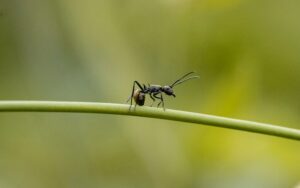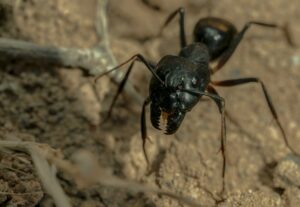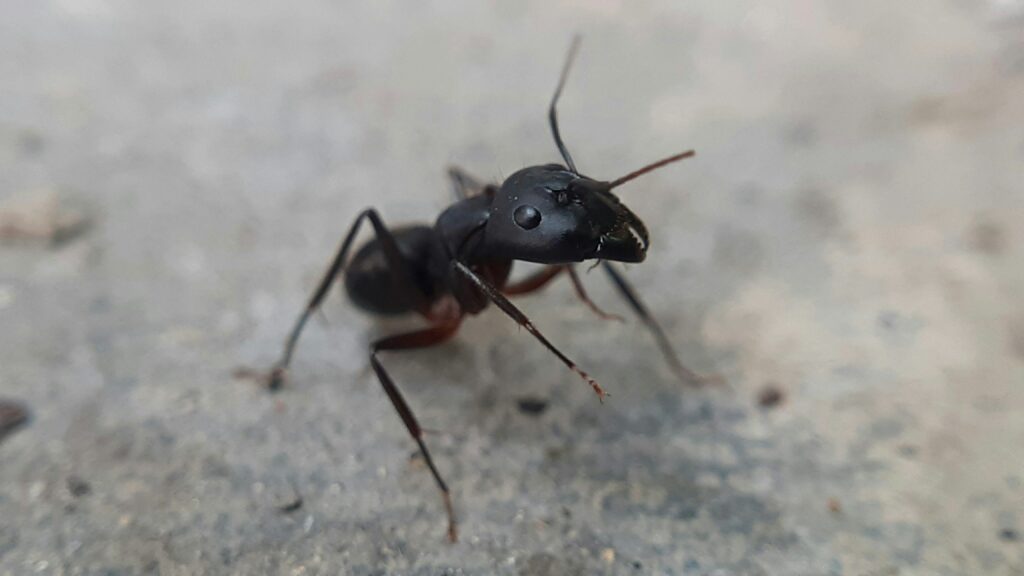It’s currently the season of carpenter ants. You may start seeing them tunneling through the ground, the wood in your walls, and into your home. In our past blogs, we’ve talked about carpenter ants and how to get rid of them. It’s currently in the middle of May, and carpenter ants are at the heights of their annual swarming, which usually lasts from April through June, sometimes September for some species.
Now, it’s time to examine their lifecycle and behavior during the spring season. Let’s start with learning what carpenter ants are.
What is a Carpenter Ant?
Carpenter ants are insects that exist in both outdoor and indoor environments, constructing colonies in wood. Unlike termites, they do not consume wood; instead, they excavate it to create hollow spaces for their nests.
Although carpenter ants are generally not harmful, their infestations can weaken tree branches, mainly in damaged trees.
They become a nuisance when they enter homes and buildings searching for food and water, nesting in areas close to these resources. If left untreated, these invasions can escalate into severe infestations.
Earlier, we mentioned that carpenter ants are most common during the spring season. Now let us explain why this happens.
Why Carpenter Ants are Most Common During the Spring Season

Carpenter ants are often more active and visible during the spring season for several reasons:
Nuptial Flights
Spring is a common time for carpenter ant colonies to conduct nuptial flights, during which winged reproductive ants (alates) emerge from mature colonies to mate and establish new colonies. The warmer temperatures and increased daylight hours of spring provide optimal conditions for these flights.
Queen Establishment
After mating during nuptial flights, fertilized queens seek suitable nesting sites to establish new colonies. Spring provides favorable conditions for queens to search for nesting sites and begin laying eggs, as temperatures rise and food sources become more abundant.
Resource Availability
Spring brings new growth and increased insect activity, providing ample food sources for carpenter ants. This abundance of food encourages foraging behavior and colony growth during this time.
Environmental Conditions
Springtime conditions, such as warmer temperatures and higher humidity levels, create favorable conditions for carpenter ant activity and colony development. These conditions support the growth of fungi and bacteria, which carpenter ants often feed on or use to help decompose wood for nest construction.
Why You Should Study the Lifecycle of a Carpenter Ant
As a business or homeowner, it is essential to understand the lifecycle of carpenter ants, especially in a season when they are most harmful. By knowing this, it is much easier to mitigate further damage. Other than knowing this, it is essential to contact your local pest control provider. Here are the key points on why you should study the lifecycle of carpenter ants as a homeowner or a business owner:
Effective Pest Control
Understanding the lifecycle of carpenter ants helps develop targeted pest control strategies. Knowing their reproductive habits, nesting behaviors, and seasonal activities, you can implement timely interventions to manage infestations.
Prevent Structural Damage
Carpenter ants excavate wood to build their nests, which can compromise the structural integrity of buildings and trees. By studying their lifecycle, you can identify the signs of an infestation early and take preventive measures to protect your property.
Eco-Friendly Solutions
Knowledge of carpenter ants’ lifecycle allows for using environmentally friendly control methods. For instance, disrupting their breeding cycle can reduce the need for chemical treatments, promoting a more sustainable approach to pest management.
Informed Decision Making
Homeowners, gardeners, and property managers can make informed decisions about maintenance and repairs. Recognizing the conditions that attract carpenter ants enables proactive steps to prevent infestations.
Scientific and Educational Value
For researchers and students, studying the lifecycle of carpenter ants contributes to a broader understanding of insect biology and ecology. It offers insights into their role in ecosystems and their interactions with other species.
Health and Safety
While carpenter ants are not typically dangerous to humans, their presence can indicate underlying moisture problems in buildings, which could lead to other issues like mold growth. Understanding their lifecycle helps in addressing these underlying problems.
Now that we’ve examined these more closely, let’s move forward on identifying carpenter ants.
How to Identify a Carpenter Ant

Identifying carpenter ants involves looking at several key characteristics and behaviors. Here’s how you can spot them:
Physical Appearance
- Size: Carpenter ants are among the largest ants, ranging from 1/4 inch to 3/4 inch (6 to 19 mm) in length.
- Color: They can be black, red, or a combination of red and black.
- Shape: They have a segmented body with a narrow, constricted waist. The thorax (the middle section of their body) is evenly rounded when viewed from the side.
- Antennae: Their antennae are bent (elbowed).
Behavior and Habits
- Nesting Habits:
- Outdoors: Look for nests in decaying wood, tree stumps, or logs.
- Indoors: They often nest in areas with damp or decaying wood, such as behind bathroom tiles, under sinks, in wall voids, or around window and door frames.
- Tunneling: Unlike termites, carpenter ants do not eat wood. Instead, they excavate it to create smooth, clean galleries. Look for sawdust-like material (frass) near these galleries, which is a sign of their activity.
- Swarming: Carpenter ants have winged reproductives that swarm to mate. Seeing winged ants indoors can indicate an indoor nest.
Signs of Infestation
- Frass: Look for piles of wood shavings mixed with parts of dead ants, indicating active nesting.
- Noise: You may hear a rustling sound coming from walls or woodwork, especially at night when the ants are most active.
- Trails: Carpenter ants typically forage at night. You might see them traveling in lines, particularly between their nest and food sources.
Comparison with Other Pests
- Termites: Unlike termites, carpenter ants have a narrow waist, bent antennae, and, when winged, two pairs of wings with the front pair larger than the back pair.
- Other Ants: Carpenter ants are generally larger and do not have the same nesting habits as smaller ants like pavement or pharaoh ants.
Inspection Tips
- Check Moist Areas: Focus on areas with moisture problems, such as bathrooms, kitchens, and basements.
- Follow Ant Trails: If you see foraging ants, try to follow their trails back to the nest.
- Use a Flashlight: A flashlight can help spot ants and their trails in dark or hidden areas.
By carefully observing these characteristics and signs, you can accurately identify carpenter ants and take appropriate measures to manage them.
Now that we’ve discussed how to identify carpenter ants, you can locate them more easily. When this happens, schedule an inspection from your local pest control service to avoid further damage to your property. By knowing facts about carpenter ants, you can explain to the experts what your current situation is, and the turnaround will be much faster for you.
Moving on, let’s learn how carpenter ants grow from the egg stage up to their colony decline and death.
The Carpenter Ant Lifecycle
Egg Stage
The lifecycle begins when the queen lays eggs. These eggs are small, oval, and typically white or translucent.
Larval Stage
After about 1-2 weeks, the eggs hatch into larvae. The larvae are legless and grub-like and are fed and cared for by the worker ants. The duration of the larval stage varies depending on environmental conditions and food availability.
Pupal Stage
Once the larvae are fully grown, they spin a cocoon around themselves and enter the pupal stage. Inside the cocoon, they undergo metamorphosis, transforming into their adult form. The pupal stage can last several weeks.
Adult Stage
After metamorphosis is complete, adult ants emerge from the pupae. These adults can be categorized into different castes: workers, queens, and males. Workers maintain the nest, care for the young, and forage for food. Queens’ primary role is to reproduce and establish new colonies. Males, which typically have wings, mate with queens and die shortly after mating.
Colony Establishment
Carpenter ant colonies begin with a single fertilized queen seeking a suitable nesting site. She lays her first batch of eggs and tends to them until they hatch into larvae. The colony grows as workers emerge and take on various tasks.
Colony Growth and Expansion
As the colony grows, workers expand the nest by excavating galleries within wood. Overcrowding may lead to the establishment of satellite colonies.
Reproduction and Nuptial Flights
Mature colonies produce winged reproductive alates. During nuptial flights, alates mate, and fertilized queens establish new colonies.
Colony Decline and Death
Colony health can decline due to habitat loss, predation, disease, and human activities, leading to eventual death.
Interactions with Humans
Carpenter ants contribute to ecosystems but can cause structural damage when nesting in human habitats. Control measures include habitat modification and targeted pesticides. They are also studied for research purposes.
Abra Kadabra: Your Ant Control Solution
High-Quality Pest Control Services In MN
While ants are small, the groups in which they travel can be large and are expected to be unwelcome guests in people’s homes. Ants can form colonies, making the problem worse if not addressed immediately. Ant infestations can occur year-round but are more common in warmer climates. A few ant species that often make their way into homes are Argentine ants, crazy ants, odorous house ants, pavement ants, pharaoh ants, thief ants, and carpenter ants.
Tips For Getting Rid of Ants
You can do a number of things on your own to get rid of ants and prevent more from coming in.
Homemade Ant Bait
A homemade bait containing borax and powdered sugar will attract ants to one location. Ants are attracted to sugar, but the borax poisons them. Ants may even carry bait to the nest, which would help get rid of ants from their central source.
Vinegar Spray
A mix of vinegar and water can be used both to deter ants and to get rid of them directly. Either spray in areas where you notice the ants traveling or spray directly onto the ants.
Sanitation & Cleanliness
Many ants are attracted to food, especially sugar. To make your home less ant-friendly, ensure there are no crumbs, spills, or garbage in your kitchen or other areas. Secure all food products and sweets and maintain clean and sanitized surfaces to make your home less attractive to ants.
Abra Kadabra is here to help. If you have an ant infestation in your home, contact us today for ant control services.
Ant Prevention
While these tips can be useful for getting rid of ants in your home, it is always best to call professionals. We will find the main source and devise a quick and safe solution for eliminating ants. Not only will we rid your home of current ants, but we will also put additional solutions in place to deter and prevent ants from entering your home.
Wrapping It Up
To sum up, we conclude that carpenter ants can potentially threaten your property, but in a slow and unidentifiable way. That’s why knowledge is power, and support from experts can save you from thousands in damages carpenter ants may cause you. If you are privy to using pesticides in extermination, it is safe to say that Abra Kadabra Environmental Services offers environmentally friendly pest control solutions. We are experts in our field, and we’ve been recognized by different organizations in the pest control industry.
Are you a homeowner or a business owner who may have a carpenter ant problem? Schedule a call now with Abra Kadabra Environmental Services. We’re happy to discuss your concerns. Call today at (763) 265 – 7820.

